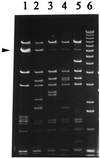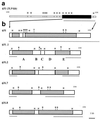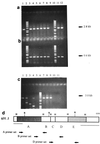Genetic analysis of chromosomal regions of Lactococcus lactis acquired by recombinant lytic phages
- PMID: 10698748
- PMCID: PMC91919
- DOI: 10.1128/AEM.66.3.895-903.2000
Genetic analysis of chromosomal regions of Lactococcus lactis acquired by recombinant lytic phages
Abstract
Recombinant phages are generated when Lactococcus lactis subsp. lactis harboring plasmids encoding the abortive type (Abi) of phage resistance mechanisms is infected with small isometric phages belonging to the P335 species. These phage variants are likely to be an important source of virulent new phages that appear in dairy fermentations. They are distinguished from their progenitors by resistance to Abi defenses and by altered genome organization, including regions of L. lactis chromosomal DNA. The objective of this study was to characterize four recombinant variants that arose from infection of L. lactis NCK203 (Abi(+)) with phage phi31. HindIII restriction maps of the variants (phi31.1, phi31.2, phi31.7, and phi31.8) were generated, and these maps revealed the regions containing recombinant DNA. The recombinant region of phage phi31.1, the variant that occurred most frequently, was sequenced and revealed 7.8 kb of new DNA compared with the parent phage, phi31. This region contained numerous instances of homology with various lactococcal temperate phages, as well as homologues of the lambda recombination protein BET and Escherichia coli Holliday junction resolvase Rus, factors which may contribute to efficient recombination processes. A sequence analysis and phenotypic tests revealed a new origin of replication in the phi31.1 DNA, which replaced the phi31 origin. Three separate HindIII fragments, accounting for most of the recombinant region of phi31.1, were separately cloned into gram-positive suicide vector pTRK333 and transformed into NCK203. Chromosomal insertions of each plasmid prevented the appearance of different combinations of recombinant phages. The chromosomal insertions did not affect an inducible prophage present in NCK203. Our results demonstrated that recombinant phages can acquire DNA cassettes from different regions of the chromosome in order to overcome Abi defenses. Disruption of these regions by insertion can alter the types and diversity of new phages that appear during phage-host interactions.
Figures






Similar articles
-
Lactococcus lactis lytic bacteriophages of the P335 group are inhibited by overexpression of a truncated CI repressor.J Bacteriol. 2002 Dec;184(23):6532-44. doi: 10.1128/JB.184.23.6532-6543.2002. J Bacteriol. 2002. PMID: 12426341 Free PMC article.
-
Homologous recombination between a lactococcal bacteriophage and the chromosome of its host strain.Virology. 2000 Apr 25;270(1):65-75. doi: 10.1006/viro.2000.0226. Virology. 2000. PMID: 10772980
-
Analysis of the genetic switch and replication region of a P335-type bacteriophage with an obligate lytic lifestyle on Lactococcus lactis.Appl Environ Microbiol. 2001 Mar;67(3):1128-39. doi: 10.1128/AEM.67.3.1128-1139.2001. Appl Environ Microbiol. 2001. PMID: 11229902 Free PMC article.
-
Structural aspects of the interaction of dairy phages with their host bacteria.Viruses. 2012 Sep;4(9):1410-24. doi: 10.3390/v4091410. Epub 2012 Aug 31. Viruses. 2012. PMID: 23170165 Free PMC article. Review.
-
Exploring the synthetic biology potential of bacteriophages for engineering non-model bacteria.Nat Commun. 2020 Oct 20;11(1):5294. doi: 10.1038/s41467-020-19124-x. Nat Commun. 2020. PMID: 33082347 Free PMC article. Review.
Cited by
-
Antisense RNA targeting of primase interferes with bacteriophage replication in Streptococcus thermophilus.Appl Environ Microbiol. 2004 Mar;70(3):1735-43. doi: 10.1128/AEM.70.3.1735-1743.2004. Appl Environ Microbiol. 2004. PMID: 15006799 Free PMC article.
-
Prophage Provide a Safe Haven for Adaptive Exploration in Temperate Viruses.Genetics. 2017 May;206(1):407-416. doi: 10.1534/genetics.116.197541. Epub 2017 Mar 17. Genetics. 2017. PMID: 28315835 Free PMC article.
-
Prophage genomics.Microbiol Mol Biol Rev. 2003 Jun;67(2):238-76, table of contents. doi: 10.1128/MMBR.67.2.238-276.2003. Microbiol Mol Biol Rev. 2003. PMID: 12794192 Free PMC article. Review.
-
Intracellular and Extracellular Expression of Bacillus thuringiensis Crystal Protein Cry5B in Lactococcus lactis for Use as an Anthelminthic.Appl Environ Microbiol. 2015 Dec 18;82(4):1286-94. doi: 10.1128/AEM.02365-15. Print 2016 Feb 15. Appl Environ Microbiol. 2015. PMID: 26682852 Free PMC article.
-
Cloning of genomic DNA of Lactococcus lactis that restores phage sensitivity to an unusual bacteriophage sk1-resistant mutant.Appl Environ Microbiol. 2001 Feb;67(2):791-8. doi: 10.1128/AEM.67.2.791-798.2001. Appl Environ Microbiol. 2001. PMID: 11157245 Free PMC article.
References
-
- Birkeland N-K, Lonneborg A-M. The cos region of lactococcal bacteriophage φLC3. DNA Sequence J. 1993;4:211–214. - PubMed
-
- Chandry P S, Moore S C, Boyce J D, Davidson B E, Hillier A J. Analysis of the DNA sequence, gene expression, origin of replication and modular structure of the Lactococcus lactis lytic bacteriophage sk1. Mol Microbiol. 1997;26:49–64. - PubMed
Publication types
MeSH terms
Substances
LinkOut - more resources
Full Text Sources

